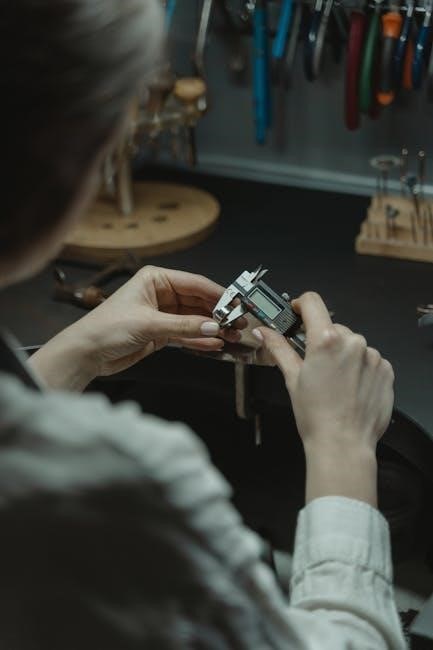A rotary tool is a versatile device for various projects, from crafting to DIY tasks․ Its customization with attachments and accessories allows for precise cutting, sanding, engraving, and more, making it indispensable for craftsmen and hobbyists alike․

Types of Rotary Tool Accessories
Rotary tool accessories include cutting wheels, sanding drums, grinding stones, engraving cutters, and carving bits․ Each type is designed for specific tasks, enhancing versatility for various materials and projects․
Cutting Accessories
Cutting accessories for rotary tools are essential for precision and versatility․ Thin cutting wheels are ideal for slicing metal pipes or small metal pieces, while diamond-coated blades excel in cutting tile, glass, or ceramics․ Fiberglass-reinforced cutting wheels are durable and suitable for heavy-duty metalwork․ Mini saw attachments transform the tool into a compact saw for detailed cuts in wood or plastic․ These accessories are designed to fit securely in the tool’s collet, ensuring safe and efficient operation․ Proper selection of cutting accessories depends on the material and desired outcome, making them indispensable for various projects․ Always follow safety guidelines and use appropriate protective gear when working with cutting tools․
Sanding and Grinding Accessories
Sanding and grinding accessories are vital for smoothing surfaces, removing rust, and polishing materials․ Sanding drums with abrasive sleeves are perfect for contour sanding, while flap wheels are designed for grinding and polishing flat surfaces․ Aluminum oxide grinding stones are durable and ideal for sharpening metal tools or removing rust․ Diamond-coated grinding bits excel in grinding hard materials like stone or ceramic․ Mandrels with sanding bands are great for detailed work on small or irregular surfaces․ These accessories come in various grits, from coarse for heavy stock removal to fine for finishing touches․ They are compatible with most rotary tools, including Dremel models, and are essential for preparing surfaces before painting or applying finishes․ Always use the appropriate accessory for your material to achieve optimal results and maintain tool efficiency․
Engraving and Carving Accessories
Engraving and carving accessories enhance precision and detail in rotary tool projects․ Diamond-coated engraving bits are ideal for intricate designs on glass, stone, and ceramic, offering sharp, clean cuts․ Carbide engraving cutters are durable and perfect for detailed work on metal and wood․ High-speed steel bits are versatile for engraving and carving various materials․ Accessories like engraving stones and diamond wheels are great for fine detailing and polishing small areas․ These tools are popular among artisans and hobbyists for creating personalized items․ Always use the correct bit for your material to achieve precise results․ Regular maintenance and proper handling ensure longevity․ Engraving and carving accessories are essential for bringing creativity to life in jewelry making, custom signs, and decorative pieces․

How to Choose the Right Accessories
Selecting the right accessories for your rotary tool is crucial to ensure optimal performance and achieve desired results․ Start by identifying the material you’ll be working with, as different bits are designed for specific tasks like cutting metal, sanding wood, or engraving glass․ Consider the project’s scope—small details may require fine-tip bits, while larger tasks need robust attachments․ Check compatibility with your tool model, as some accessories are brand-specific․ Read reviews and manuals to understand the best applications for each accessory․ Budget is also a factor; invest in quality bits that offer durability and precision․ Proper selection enhances efficiency and safety, ensuring your rotary tool operates effectively for any project․ Always refer to manufacturer guidelines for recommendations tailored to your tool and task requirements․
Safety Precautions When Using Rotary Tools
Operating a rotary tool safely requires attention to several key precautions․ Always read the manual thoroughly to understand the tool’s capabilities and limitations․ Wear protective gear, including safety goggles, gloves, and a dust mask, to shield yourself from debris and dust․ Ensure the work area is well-ventilated to avoid inhaling harmful particles․ Keep loose clothing or long hair tied back to prevent accidental entanglement․ Avoid overloading the tool, as excessive pressure can lead to overheating or breakage․ Use the correct accessory for the material being worked on to minimize risks․ Keep children and pets away from the workspace․ Never leave the tool unattended while it is in operation․ After use, allow the tool to cool down before storing it in a safe, dry place․ Proper safety practices ensure a safe and efficient working experience with your rotary tool․

Popular Rotary Tool Brands and Their Accessories
Dremel and Bosch are leading brands, offering high-quality rotary tools and accessories․ Dremel’s EZ SpeedClic system enables quick accessory changes, while Bosch provides durable mandrels and bits for diverse applications․
Dremel EZ SpeedClic System
The Dremel EZ SpeedClic system is a revolutionary accessory change mechanism designed for efficiency and convenience․ This system allows users to switch between different rotary tool accessories up to four times faster than traditional methods, significantly reducing downtime during projects․ By eliminating the need for a wrench, the EZ SpeedClic system streamlines the process, making it easier to adapt to various tasks such as cutting, grinding, and sanding․ The system is compatible with a wide range of Dremel accessories, ensuring versatility for different materials and applications․ Its quick-change capability enhances workflow, making it ideal for both professionals and hobbyists who value speed and precision․ Additionally, the EZ SpeedClic system maintains the high standards of quality and durability that Dremel is known for, ensuring reliable performance across all projects․
Quick-Change Systems for Efficiency
Quick-change systems for rotary tools are designed to enhance productivity and streamline workflows․ These systems allow users to swap accessories rapidly, minimizing downtime and increasing efficiency․ Many modern rotary tools, such as the Dremel EZ SpeedClic, feature quick-change mechanisms that eliminate the need for wrenches, enabling seamless transitions between tasks․ This innovation is particularly beneficial for projects requiring frequent accessory changes, such as cutting, grinding, and polishing․ Quick-change systems also reduce wear and tear on both the tool and accessories, ensuring longevity․ With compatibility across a wide range of materials and tasks, these systems are indispensable for professionals and hobbyists alike, offering convenience and precision in every project․

Guide to Installing and Removing Accessories
Installing and removing accessories on a rotary tool requires precision to ensure safety and optimal performance․ Begin by selecting the correct collet for the accessory, ensuring it matches the shank size․ Secure the collet in the tool’s chuck, tightening it firmly with the provided wrench․ For tools with quick-change systems, such as the Dremel EZ SpeedClic, simply align the accessory and click it into place․ When removing, reverse the process, loosening the collet and carefully pulling out the accessory․ Always refer to the manufacturer’s manual for specific instructions, as improper installation can lead to damage or unsafe operation․ Proper handling ensures longevity of both the tool and its accessories, making your projects more efficient and enjoyable․ Regularly inspect accessories for wear and replace them as needed to maintain precision and safety․

Organizing Your Rotary Tool Accessories
Organizing your rotary tool accessories is essential for efficiency and safety․ Start by using a storage case or container with separate compartments to keep accessories sorted and easy to find․ Label each section for quick identification, such as “Cutting Bits” or “Sanding Drums․” Store the most frequently used accessories in easy-to-reach locations, while less common ones can be placed in less accessible areas․ Consider grouping accessories by type or project use to streamline your workflow․ Regularly clean and inspect your accessories to ensure they remain in good condition and function properly․ For added convenience, keep a small portable case for transporting tools and accessories to different workspaces․ Maintaining an organized system prevents damage, saves time, and enhances your overall experience with rotary tools․

Tips for Specific Projects
When working on specific projects with your rotary tool, choosing the right accessory is crucial․ For cutting metal, use a diamond cutting wheel for precise results․ Sanding delicate surfaces like glass or plastic requires soft-grit sanding drums to prevent scratches․ Engraving intricate designs benefits from fine engraving cutters, while carving wood is best done with carbide carving bits․ Always match the accessory to the material and task for optimal performance․ Maintain consistent pressure to avoid overheating the tool, which can damage both the accessory and the material․ Start with low speeds and gradually increase as needed, especially when working with fragile materials․ Testing on a scrap piece first ensures the desired outcome․ By selecting the right accessory and applying these techniques, you can achieve professional-quality results in your projects․
Troubleshooting Common Issues
When using rotary tools, common issues like accessories not fitting properly or overheating can arise․ Ensure the collet and mandrel are securely attached and compatible with your tool․ Overheating often occurs from excessive pressure; maintain steady, light pressure and allow the tool to cool between uses․ If accessories wear out quickly, check for proper installation and speed setting․ For poor performance, verify that the accessory matches the material being worked on․ Vibration issues may indicate a loose collet or damaged accessory․ If the tool doesn’t turn on, inspect the power cord and connections․ For persistent problems, consult the manual or contact customer support․ Regular maintenance, like cleaning the tool and storing accessories properly, can prevent many issues․ By addressing these common problems, you can ensure smooth operation and extend the life of your rotary tool and its accessories․
For further learning, explore resources like the Dremel Accessory Guide or Rotary-Tool․com․ These provide in-depth reviews, tutorials, and project ideas․ Additionally, online forums and video tutorials can offer practical insights and troubleshooting tips․ Finally, consider exploring brand-specific resources, such as the Dremel EZ SpeedClic system guide, to maximize your tool’s efficiency․ Keep experimenting and refining your skills to make the most of your rotary tool experience!
